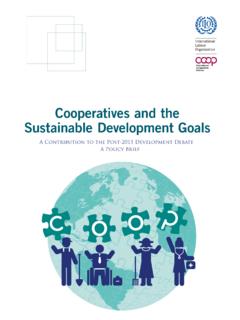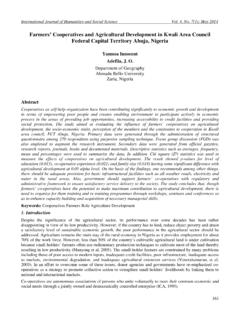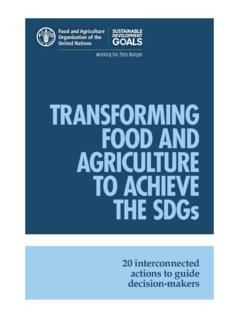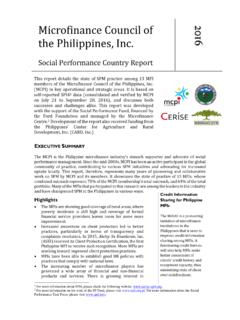Transcription of Small-Scale Oyster Farming for Chesapeake Watermen A ...
1 Small-Scale Oyster Farming for ChesapeakeWatermenA sustainable Business Marketing PlanPrepared for the Campbell Foundation for the Environment,Towson, MDbyRobert S. KallenKevin J. MorseDaniel J. GrosseDorothy L. LeonardTerrAqua Environmental Science and Policy, LLC3754 Jenifer Street NW Washington, DC 20015202-244-4300 20012 AcknowledgementsWe thank Eric Campbell (Maryland Department of Natural Resources), Keith Campbell(Campbell Foundation for the Environment), Vivian Cavalieri, Charles Frentz (OysterRecovery Partnership), Kurt Friesland ( McDonnell & Company seafood wholesalers),Chris Judy (MD DNR), Daniel Kauffman and Robert Lane (Virginia Tech AgriculturalResearch and Extension Center), Connie Lewis (MD DNR), Doug Outten (MD DNR), ChrisPauly (DePaul University), Kennedy Paynter (University of Maryland Department ofZoology), Robert Rheault (Moonstone Oyster Company), Jack White (New Point OysterCompany), Smith Island Watermen Bill Dize and Eddie Evans, and many chefs, buyers andretailers in the Washington-Baltimore metropolitan area and beyond for their input,advice and study was made possible by a grant from the Campbell Foundation for theEnvironment, through the nonprofit Oyster Recovery SUMMARYG oalsThis program has two goals:1.
2 To help local Watermen communities around Chesapeake Bay develop small-scalesustainable Oyster farms that offer an additional economic option compatible withtheir lifestyles and To help restore wild local Oyster populations. The Watermen can increase their economic return by producing oysters almost year-round(rather than seasonally), and marketing the final these goals requires:1. High-quality oysters , consistently delivered at a reasonable price. 2. Creating and sustaining a long-term demand for these oysters by, among otherthings, educating the market about the heritage of Chesapeake Bay oysters and thewatermen s desire to preserve their lifestyle. RisksSuccess requires understanding and controlling for certain risks: The volatility of the half-shell Oyster market. Diseases that could damage the oysters as they grow to maturity. Competition from other suppliers outside the region. The slight risk of other diseases associated with raw oysters , which could havean adverse effect on a small percentage of consumers with weakened immunesystems.
3 Extensive federal and state regulatory programs monitor the productionand marketing of raw shellfish to assure product safety, thereby minimizing of half-shell oysters from the Chesapeake are unreliable and inconsistent at best, butthe Washington-Baltimore market can obtain half-shell oysters from the Northeast, the Gulfand even the West Coast. However, demand for premium Chesapeake Bay oysters remainshigh. Ad hoc market research showed high quality Chesapeake Bay oysters to be an easy sell in themetropolitan market. A consistent quantity supplied might well increase demand. 4 OutcomesThe majority of Washington, DC-area restaurants and seafood wholesalers and retailers thattasted the Smith Island oysters have responded positively; several immediately placed team also introduced the Smith Island Watermen to one of the largest seafoodwholesalers in Jessup, Maryland. After tasting the oysters , the wholesaler offered topurchase, at a premium price, the entire amount of oysters currently being grown.
4 A cost-effective distribution system was identified to transport the crop to Jessup. The watermenexpect to make their first deliveries in fall 2001. They have also ordered more seed oystersand supplies to construct additional culture equipment so as to continue and expand theirexisting recommend that, at least initially, the Watermen continue to work with wholesalers toestablish a market presence and create brand recognition for their oysters . This will decreasestartup costs, streamline distribution logistics, and immediately establish a revenue the Watermen refine their operation and improve their means of delivery, they may test theviability of direct sales to restaurants and seafood markets, or even sales to tourists on outcomes of the project, the market research and interviews conducted for the purpose ofthis study, and the financial model developed for the Smith Island Watermen show that anoyster aquaculture operation that caters to the high-end half-shell market in the Washington-Baltimore area has the potential for becoming a sustainable and profitable business OF CONTENTSEXECUTIVE OF Project Project Overview and Product Risk to Sourcing of Seed oysters and Oyster Oyster Growth HALF-SHELL Oyster Competitive NICHE AND COMPETITIVE Direct Requirements and Requirements and Internet Retail and Wholesale Distribution and AND ORGANIZATIONAL Personnel PLAN sales.
5 19 Wholesale .. CULTURE FACT 350-some inhabitants of Smith Island, MD are the direct descendants of British colonistswho settled this Chesapeake Bay island in the early 1700s. To this day, the islanders stillspeak English with holdover accents and speech patterns from Elizabethan Cornwall. Theisland s economy has long depended on crab and Oyster harvesting, the occupation of mostadults to this day. But a diminishing resource base threatens their lifestyle. Chesapeake Bay Oyster (Crassostrea virginica) populations have declined significantly sincethe 1880s when the industry harvested about 15 million bushels (about 525,000 tons)annually. In 1998 only 148,000 bu. (5,180 t) were landed less than one percent of historiclevels. Overharvesting, habitat degradation and disease have contributed to this decline, andthe wild harvest industry on Smith Island is no longer economically viable. Watermen donot want to give up their ability to harvest oysters from public grounds, but it has becomeincreasingly difficult to support families and continue in the island s tradition.
6 Many youngislanders are seeking employment opportunities Project SummaryThe project was created through a two-part Chesapeake program that involved technicalworkshops and demonstration projects, followed by marketing assistance and extensionsupport. The project team decided to start small, with one workshop, then expand theproject depending on the Watermen 's interest. Team participants come from state and federalnatural resource management agencies, academia, and non-profit and for-profit organizationsinvolved in sustainable aquaculture and agriculture development, pollution prevention, andthe food Farming workshops were conducted on Smith Island and on nearby Tangier Island,VA in July 1998. Experts gave overviews of topics ranging from nursery and grow-outtechniques to marketing and government regulations, followed by equipmentdemonstrations. A pilot Oyster culture project was begun in spring 1999 in the town of Ewing, MD, on SmithIsland, in Levering Creek, a state-approved shellfish growing area off Tangier Island Watermen Bill Dize and Eddie Evans jointly own the project.
7 Both men, formerpresidents of the Tangier Sound Watermen s Association, are prominent Smith Islandresidnts. They have not yet signed any formal agreements for cooperatives or project will file for a for-profit status within state of Maryland within the immediatefuture. Funding for the project has come from private foundations (Campbell Foundation for theEnvironment, Community Foundation of the Eastern Shore, Chesapeake Bay Trust),government (Office of sustainable Development, USDOC), and in-kind providers such asTerrAqua, the University of Maryland and the Maryland Department of Natural Project Overview and StatusThe first seed oysters (45,000) were provided in July 1999. By September 1999 the oystershad grown almost ten-fold. The Watermen were sufficiently impressed that they requestedmore seed oysters , and were provided with an additional 12,000 in October 1999. ByNovember 1999 the largest oysters from the July seeding were about 3 long, and appearedrobust.
8 The Watermen received an additional 20,000 seed oysters in August 2000. Oystermortality has been negligible in the grow-out operation. Total start-up costs wereapproximately $6,400 (See breakdown of costs in Table ).The Watermen are receiving ongoing technical and marketing advice, and Oyster diseasemonitoring. They are maintaining and expanding the growing operations. One husband andwife team plan to start a weekend bed and breakfast that will include a cultured Oyster will become Smith Island s second B& aspect of the overall project will be seeding cultured oysters around the island, to re-establish local wild Oyster beds that can be harvested in the future. These temporarysanctuaries can allow disease-tolerant brood stock to proliferate, add habitat and improvewater participants plan to continue and expand on the Smith Island project. Within SmithIsland, they plan to help participating Watermen expand their operations and to assist otherinterested Watermen start their own operations.
9 They also plan to export this approach toother interested local Watermen communities an interest that seems to be costsItemsCostSeed oysters $560 Culture floats (20)1,920 Legal (LLC development)1,000 Power washer300 Shipping supplies:Staple machine [for fastening shipping boxes] ($300)Waxed shipping boxes ($440)Waterproof Oyster tags ($48)Ice chests ($450)Thermometers ($20)Box labels ($100)1,358 Liability insurance 750 Safe seafood handling (HAACP) certification 150 Permanent Water Column Aquaculture Permit (MD) 250 Miscellaneous 100 Total $6,388 Note: In-kind contributions for the Smith Island project are not included. If Watermen in other regionswant to initiate a similar project, it would cost approximately $1,500 to bring in the consulting team forinitial training, construction of sample floats, and overview of the business to be developed will be high-quality, single raw oysters for the half-shell Product DescriptionTo be sold as appetizers in oysters restaurants and seafood markets, the oysters must attain asize of 2-1/2 to 3-1/2 and larger.
10 oysters not reaching this size can sometimes be sold as shooters or cocktail oysters for a discounted price. The key to selling the oysters ,according to the chefs, buyers and established growers with whom we spoke, rests onquality, consistency, and cleanliness. The product will need have an appealing salty flavorand be available almost Risk to ProductThe major diseases of wild oysters in Chesapeake Bay, Dermo (Perkinsus marinus) andMSX (Haplosporidium nelsoni), are likely to persist indefinitely. MSX, which tends toaffect oysters in early life stages, does not yet appear to have affected the Smith Islandoysters in culture. Dermo, which was detected in 2000 but not in 2001, affects olderoysters. To minimize the likelihood of affecting Oyster culture in Tangier Sound, the projectis managing around and minimizing exposure to disease. The brood stock had survivedearlier disease epizootics. The faster growth from suspended culture minimizes the growingtime to market size and may minimize the likelihood of this age-related disease.





